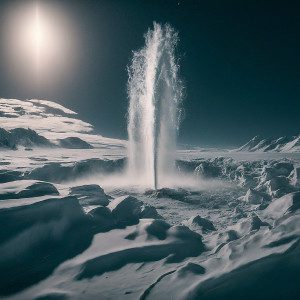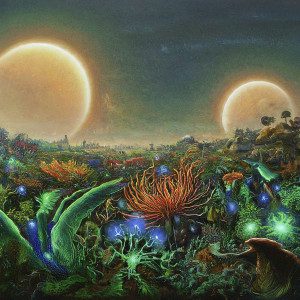Saturn’s moon Enceladus has captured the imaginations of astronomers and space enthusiasts alike for centuries. Discovered by William Herschel in 1789, this icy moon has proven to be a treasure trove of secrets, waiting to be uncovered by scientific exploration. NASA’s Cassini spacecraft, launched in 1997, has played a pivotal role in unraveling some of Enceladus’s enigmatic mysteries. In this exploration, we will delve into the top five secrets of Enceladus, shedding light on the captivating phenomena that make this moon so intriguing.
-
Introduction: Enceladus – A Frozen World of Wonders
Enceladus, Saturn’s sixth-largest moon, is a celestial body shrouded in mystery. With a diameter of just 504 kilometers, it is one of the smallest moons in the solar system. However, its diminutive size belies the astonishing phenomena that occur within its icy realm. From towering geysers that erupt from its surface to a hidden subsurface ocean, Enceladus continues to captivate scientists and space enthusiasts alike.
The discovery of Enceladus dates back to the late 18th century when William Herschel first observed this distant moon through his telescope. Since then, advancements in space exploration have allowed us to study Enceladus in unprecedented detail, revealing its secrets one by one.
Enceladus’s most prominent feature is its striking icy surface, which reflects sunlight with remarkable brilliance. This icy exterior is adorned with intricate patterns of cracks and ridges, known as “tiger stripes,” hinting at a tumultuous geological history. Moreover, Enceladus is renowned for its geysers, which shoot water vapor and icy particles hundreds of kilometers into space from its south pole.
Beyond its surface features, Enceladus harbors a hidden subsurface ocean, discovered in 2005 by the Cassini spacecraft. This vast reservoir of liquid water has ignited speculation about the potential for extraterrestrial life, making Enceladus a focal point of astrobiological research.
As we embark on this journey to unravel the secrets of Enceladus, we are reminded of the vast mysteries that await exploration within our cosmic backyard. Join us as we delve into the top five secrets of Enceladus, each unveiling a new facet of this enigmatic moon’s captivating allure.
Secret #1: The Hidden Subsurface Ocean

The world was stunned by the groundbreaking revelation that Enceladus, a distant moon, conceals a hidden ocean beneath its icy exterior. This astonishing discovery, made possible by the Cassini spacecraft in 2005, completely revolutionized our understanding of this celestial body. It all started with the detection of water vapor plumes erupting from the moon’s southern pole, which hinted at the presence of a vast reservoir of liquid water. As the spacecraft continued to investigate, subsequent flybys and precise measurements confirmed the existence of a massive subsurface ocean that spans hundreds of kilometers beneath the frozen surface.
The discovery of this hidden ocean has profound implications for our understanding of Enceladus’s potential for harboring life. Liquid water is a key ingredient for life as we know it, and the presence of a subsurface ocean raises the tantalizing possibility of microbial life existing within Enceladus’s icy depths. Moreover, the ocean’s dynamics, chemistry, and potential habitability are areas of active research, with scientists eager to uncover its secrets.
The origins and composition of Enceladus’s subsurface ocean remain a subject of intense study. How did it form, and what processes maintain its liquid state beneath the moon’s icy crust? These questions continue to intrigue researchers, driving further exploration and analysis to unlock the mysteries of Enceladus’s hidden ocean.
Future missions and spacecraft are being planned to delve deeper into Enceladus’s subsurface ocean, probing its icy shell and analyzing the composition of the plumes. By studying the chemical composition of the water vapor and icy particles ejected from the moon’s surface, scientists hope to gain valuable insights into the potential habitability of Enceladus and the conditions necessary for life to thrive in its subsurface ocean.
The discovery of a hidden subsurface ocean on Enceladus represents a significant milestone in our exploration of the solar system. It underscores the importance of planetary exploration in unraveling the mysteries of our cosmic neighborhood and holds the potential to revolutionize our understanding of the origins and distribution of life in the universe.
Secret #2: The Enigmatic Geysers of Enceladus

One of the most captivating features of Enceladus is its geysers, which erupt from the moon’s south pole with breathtaking force and beauty. Discovered by the Cassini spacecraft in 2005, these towering plumes of water vapor and icy particles have puzzled scientists and space enthusiasts alike, offering a mesmerizing glimpse into the moon’s hidden depths.
The origin of Enceladus’s geysers is closely linked to its subsurface ocean. Scientists believe that these geysers originate from hydrothermal vents on the moon’s ocean floor, where heated water interacts with rock and ice, creating immense pressure that forces water to erupt through fractures in the icy crust. This process, known as “cryovolcanism,” is thought to be responsible for the spectacular geysers observed on Enceladus.
Studying Enceladus’s geysers provides valuable insights into the moon’s internal dynamics and potential for habitability. By analyzing the composition of the plumes ejected from the moon’s surface, scientists can infer the chemical composition of its subsurface ocean and assess its suitability for life. The presence of organic molecules and other compounds within the plumes further enhances the moon’s astrobiological potential, raising exciting possibilities for the existence of microbial life within its icy depths.
Intriguingly, the geysers of Enceladus also offer clues about the moon’s geological history and evolution. By mapping the distribution and behavior of the geysers, scientists can reconstruct the moon’s tectonic activity and understand the processes that shape its surface features. This knowledge helps us piece together the puzzle of Enceladus’s complex geology and unravel the mysteries of its icy facade.
As we continue to study Enceladus’s geysers and unravel their secrets, we inch closer to unlocking the mysteries of this enigmatic moon and understanding its potential for hosting life. Future missions and advancements in technology promise to shed further light on this captivating phenomenon, paving the way for discoveries and insights into the nature of our solar system and the universe beyond.
Secret #3: The Potential for Extraterrestrial Life

Enceladus’s potential for hosting extraterrestrial life has long been a topic of speculation and debate among scientists. The discovery of its subsurface ocean and geysers has heightened excitement about the moon’s astrobiological potential, fueling speculation about the existence of microbial life within its icy depths.
The subsurface ocean of Enceladus is believed to be in direct contact with the moon’s rocky core, creating a dynamic environment that could potentially harbor life. The presence of hydrothermal vents on the moon’s ocean floor further enhances its astrobiological potential, as these vents provide energy and nutrients that could support a thriving ecosystem of microbial organisms.
Observations made by the Cassini spacecraft have revealed the presence of organic molecules and other essential building blocks of life within the plumes ejected from Enceladus’s surface. These organic compounds, along with the presence
of liquid water and the energy provided by hydrothermal activity, create a tantalizing environment for the emergence and sustenance of life.
The search for extraterrestrial life on Enceladus is a complex and multifaceted endeavor that requires careful planning and the development of advanced technologies. Future missions, such as NASA’s upcoming Europa Clipper, aim to explore Enceladus and its subsurface ocean in greater detail, potentially unveiling more secrets and shedding light on the possibility of life beyond Earth.
Exploring the potential for extraterrestrial life on Enceladus represents a significant milestone in our quest to understand the origins and distribution of life in the universe. If microbial life were to be discovered on Enceladus, it would have profound implications for our understanding of biology, chemistry, and the potential for life elsewhere in the cosmos. Moreover, it would underscore the importance of exploring icy moons and other celestial bodies in our search for extraterrestrial life.
The discovery of extraterrestrial life on Enceladus, if it were to occur, would be one of the most significant scientific breakthroughs in human history. It would fundamentally alter our perspective on the nature of life and its prevalence in the universe, opening up new avenues of exploration and inquiry. Moreover, it would inspire future generations of scientists and explorers to continue pushing the boundaries of our knowledge and understanding of the cosmos.
As we continue to unravel the mysteries of Enceladus and explore its potential for hosting extraterrestrial life, we are reminded of the profound questions that drive scientific exploration. Are we alone in the universe? What conditions are necessary for life to emerge and thrive? By studying worlds like Enceladus, we inch closer to answering these fundamental questions and unlocking the secrets of our cosmic origins.
Secret #4: The Enigmatic Tiger Stripes and Their Significance

Stretching across Enceladus’s south pole are enigmatic features known as “tiger stripes,” named for their resemblance to the stripes on a tiger’s coat. These narrow fissures in the moon’s icy crust are not merely decorative; they play a crucial role in the moon’s dynamic geology and the perplexing phenomenon of its geysers.
The significance of the tiger stripes lies in their connection to Enceladus’s subsurface ocean. These cracks act as conduits, allowing water from the ocean to escape into space in magnificent plumes. The discovery of this mechanism revolutionized our understanding of Enceladus and opened up exciting possibilities for the existence of alien life within our solar system.
The ongoing exploration of Enceladus has provided valuable insights into the complex interactions between its internal ocean, icy shell, and the external environment. Researchers have used data from the Cassini spacecraft to study the composition of the plumes and gather evidence of hydrothermal activity. These findings have further fueled speculations about the potential habitability of this distant moon.
Despite the progress made in unraveling the secrets of Enceladus, the precise mechanisms behind the formation and maintenance of the tiger stripes remain elusive. Scientists are actively researching the forces at play, including tidal interactions with Saturn and the gravitational influence of other moons. The answers to these questions could provide valuable insights into the dynamics of icy moons and their potential for hosting life.
As our exploration of Enceladus continues, the enigma of the tiger stripes persists, reminding us of the vastness and complexity of the universe. These captivating features serve as a testament to the mysteries that await discovery in the depths of space, urging scientists and enthusiasts alike to delve deeper into the secrets of this enigmatic moon.
Secret #5: The Puzzling Heat Signature of Enceladus

Deep within the frigid reaches of space, Enceladus holds a secret that continues to baffle scientists and ignite curiosity: its peculiar heat signature. Despite its small size and icy appearance, this celestial body emits a surprising amount of thermal energy, challenging our understanding of planetary processes.
The discovery of this puzzling heat source on Enceladus has opened up a Pandora’s box of questions for researchers. One prevailing theory suggests that Enceladus possesses a hidden subsurface ocean of liquid water, kept in a liquid state by the tidal forces exerted by Saturn’s gravity. This ocean, in direct contact with the moon’s rocky core, generates internal friction and heat, contributing to the moon’s thermal signature.
Another hypothesis proposes that the heat signature arises from tidal forces. Enceladus, locked in a gravitational dance with Saturn, experiences intense tidal stresses. These gravitational interactions generate internal friction, creating heat and maintaining the moon’s subsurface ocean in a liquid state.
The discovery of plumes erupting from Enceladus further adds to its mystique. These towering geysers, spewing water vapor and icy particles into space, serve as tangible evidence of the moon’s active nature. The origin of these plumes, their connection to the enigmatic heat signature, and their potential role in the search for extraterrestrial life continue to captivate astronomers and astrobiologists.
Unraveling the secrets of Enceladus requires a delicate balance of scientific ingenuity and exploration. Missions like NASA’s Cassini spacecraft have provided valuable insights into the moon’s complex geology and the composition of its plumes. Future missions, such as the proposed Enceladus Life Finder, aim to delve even deeper into the mysteries that this moon holds, seeking clues to the origin of life beyond Earth.
As the mysteries of Enceladus persist, scientists and dreamers alike eagerly await the day when its secrets will be fully revealed. Until then, this enigmatic moon will continue to mesmerize us with its perplexing heat signature, beckoning us to explore its frozen depths and uncover the truth that lies hidden within.
-
The Implications of These Mysterious Secrets
The secrets of Enceladus are not only intriguing but also carry significant implications for our understanding of the universe and the potential for extraterrestrial life. These enigmatic discoveries have sparked immense curiosity among scientists and space enthusiasts alike.
Firstly, the presence of water on Enceladus opens up a realm of possibilities. The subsurface ocean, with its potential for liquid water, heat, and chemical reactions, creates a promising environment for the existence of microbial life. This finding has led to the intriguing concept of habitability beyond Earth, igniting the search for life in our solar system.
Moreover, the discovery of complex organic molecules on Enceladus adds another layer of fascination. These molecules, the building blocks of life as we know it, suggest that the moon’s subsurface might harbor the necessary ingredients for life to emerge. The implications of this finding extend beyond Enceladus itself, as it raises the possibility of life existing in similar environments elsewhere in the universe.
The mysterious plumes erupting from the moon’s south pole also bear significant implications. These geysers spew water vapor, along with other volatile substances, into space. Studying the composition of these plumes provides valuable insights into the moon’s subsurface chemistry and the potential for chemical reactions that could support life.
Furthermore, the energy needed to sustain these geysers remains an enigma. The tidal forces exerted by Saturn’s gravitational pull on Enceladus generate immense heat, contributing to the moon’s geological activity. Understanding the mechanics behind this energy transfer could provide valuable knowledge about the dynamics of other celestial bodies and their potential for hosting habitable environments.
Finally, the discovery of hydrothermal vents on Enceladus represents a groundbreaking revelation. These vents, similar to those found on Earth’s ocean floor, provide a source of energy and nutrients that could support microbial life. The presence of such hydrothermal systems on Enceladus suggests that the conditions for life may exist in unexpected places within our solar system and beyond.
In summary, the secrets of Enceladus hold profound implications for our understanding of the universe and the potential for life beyond Earth. From its hidden subsurface ocean to its towering geysers and enigmatic heat signature, this icy moon continues to captivate our imagination and inspire scientific inquiry. As we continue to unravel the mysteries of Enceladus through exploration and discovery, we move one step closer to answering some of the most fundamental questions about our place in the cosmos and the existence of life elsewhere in the universe.

